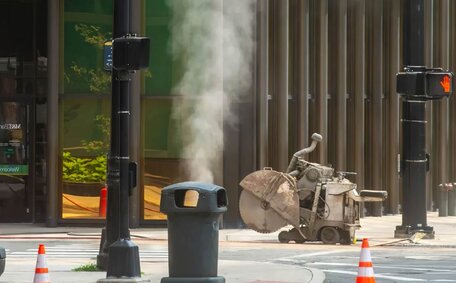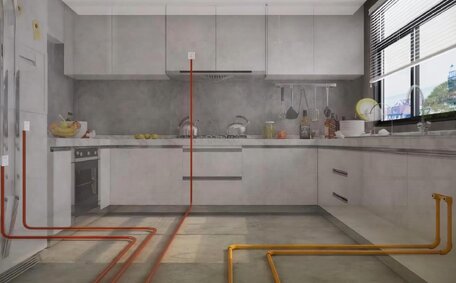
How To Move A Gas Meter
Need your gas meter relocated? You can’t move it yourself - contact your supplier to arrange for a gas engineer to reposition it safely. Charges may apply depending on circumstances.
Read MoreTree root invasions are commonplace in sewer systems due to their quest for moisture and nutrients, which sewer lines abundantly offer, leading to persistent root growth.
Understanding root penetration mechanisms helps develop effective prevention strategies. Pipe relining and regular inspections are crucial to managing root invasions effectively.
Root intrusion can damage plumbing systems as roots grow and expand within your home’s pipes. Prior to pipe repair, we may have to remove trees or their roots that have made their way into pipe cracks or loose joints, which then continue to expand as time passes. This process widens cracks and openings, facilitating further root entry from your pipes into the sewer system.
As more tree roots infiltrate your sewer pipes, they form dense root balls that can lead to clogs akin to a blocked down toilet. Over time, it’s critical to remove tree roots in your sewer line which can become almost completely clogged with thick masses of them. Consequently, gurgling sounds and signs blocked within your sewage system lead to reduced flow, causing backups, messy overflows, and unpleasant odours.
Tree roots can grow into all types of buried your drain pipes around the home. External pipes drains are particularly susceptible, including your sewer laterals and main pipes, along with other drainage systems and leach drains. Additionally, tree roots can infiltrate internal plumbing, impacting sinks, showers, water pipes, vent stacks, and beyond.
Without control strategies, root intrusions can cause significant damage leading to complete pipe replacement. However, new pipe relining technology enables actions to clear tree roots and reinforce your drain from the inside, sealing all vulnerabilities to permanently prevent future root intrusions.
Pipe relining is an optimal solution for homes contemplating tree placement near tankless water heaters, as it addresses root intrusion from within your drainage pipes. This trenchless method inserts an epoxy resin lining that coats the inner walls, sealing cracks and gaps. With no entry points, tree roots can no longer invade and push roots out your pipe or cause blockages.
Our team specialises in pipe relining, offering durable protection against root damage. This technique also reinstates the hydraulic capacity of partially blocked drains. The robust internal barrier created prevents roots and soil ingress, effectively protecting against blockages for decades.
We use CCTV camera technology during the insertion of flexible pipe liners into the drain pipe, then cure them with hot water or steam to mould a smooth, jointless flow surface.
Pipe relining is recognised as a highly efficient and minimally invasive alternative to traditional pipe replacement. It requires no digging or destruction to paths, lawns or landscaping.
The technique can address plumbing problems by most likely restoring integrity to damaged pipes within your sewer system under buildings and sensitive areas. With CCTV inspections, we can assess the full extent of tree root intrusions and relined the affected sections.
Our pipe relining offers a long-term solution compared to the temporary fixes of root cutting or chemical treatments. Contact Our team, to prevent tree roots drain blockages with long-term protection and minimal disruption to your property.
Pipe relining can stop tree roots with an effective step-by-step solution into drainage systems. Here is an overview of the key stages for addressing blocked pipes:
With expertise in the latest trenchless relining technology, Menai Plumbing can restore and reinforce pipes where roots find their way in for long-term durability. Contact us to learn more or book an on-site assessment.
Conducting thorough pipe assessments is crucial prior to relining to determine the optimal solution. We use CCTV inspections to visually examine the full extent of roots sewer line intrusions and identify other defects like cracks or blockages.
Key inspections entail:
Armed with accurate pipe condition data from CCTV and pipe scanning, we can plan the perfect relining approach. We’ll clear any sections needing replacement or pretreatment for optimal results.
Thorough assessments ensure no nasty surprises mid-job and the best long-term outcome. Contact us to schedule an inspection so we can profile your pipes and customise an effective relining strategy.
Before relining pipes affected by tree roots, we first clear any major blockages to ensure the smooth flow of the new liner. We use specialised hydro jetting equipment that generates up to 5000 PSI of water pressure to dislodge root masses.
This high-powered water jet cuts through even the densest root bundles, clearing a path for the liner in the drain line. It’s an eco-friendly and effective method without chemicals. For smaller roots, our goal is to get rid roots using mechanical cutting tools to clear them from the pipe walls prior to installation.
Removing obstruction debris creates optimal conditions for long-lasting pipe relining results. It allows the liner to fully adhere to the inner pipe surface with no gaps for future root regrowth. Pre-treating significant blockages streamlines the relining process for efficient pipe reinforcement.
Our professional plumbers meticulously install the resin-impregnated liner into the damaged pipes. We thoroughly clean your pipes, demonstrating pipes how high-pressure water jets remove any remaining roots or debris. This clears the way for smooth installation of the lining.
The liner itself is a fabric tube saturated with durable epoxy resin.
Our technicians carefully feed the collapsed liner into the pipe and use compressed air or water to inflate it so it fully conforms to the pipe walls. The lining is allowed to harden before pumping hot water or steam to cure the resin and form a robust internal barrier.
The pipe relining technology we deploy is durable, with an expected service life of 50 years. It adheres tightly to the native pipe and seals leaks, restoring hydraulic capacity and eliminating any entry points for future root regrowth. The process is completed without excavating or disturbing your property or landscaping.
With CCTV monitoring throughout, we ensure every section of pipe is reinforced and protected from tree roots for decades to come. Contact Menai Plumbing to arrange an obligation-free assessment and discuss leak-proofing your drained with seamless pipe relining.
After installing the epoxy liner, we use hot water or steam to cure and set the resin. This bonds the liner into a tough, jointless barrier that keeps roots out. Temperatures up to 180°F are pumped inside to activate and fully polymerise the epoxy resin.
Curing transforms the flexible liner into a rock-hard, impermeable pipe lining with excellent chemical resistance. It also creates a smooth surface for optimal hydraulic flow. We monitor progress with CCTV and temperature gauges until the process is complete, usually within 2-3 hours.
We take care to evenly heat all sections to prevent cold spots and ensure the robust integrity needed to withstand decades of root pressure. This vital final step locks the liner into place for long-term durability and helps to keep roots out, preventing damage caused by roots even under tree root attack.
With advanced pipe relining and curing methods, Menai Plumbing can permanently reinforce your drainage system against invasive tree roots. Contact us to learn more or book a no-obligation quote.
There are several effective strategies Menai homeowners can adopt to help prevent future tree root intrusions after pipe relining:
Plant trees no closer than 3 metres from drainage systems to avoid root invasions. Given that a tree’s root system can spread to twice its height, maintaining an adequate buffer zone is vital. For existing trees near your pipes, tree root barriers can help guide roots away as they grow.
Schedule an annual CCTV drainage inspection to check for potential root regrowth or new intrusions. Catching issues early allows for quick treatment before major blockages occur.
Your blocked sewer pipes can be safeguarded by using root barriers such as pipe shields, filter sleeves, and grated covers around high-risk drainage areas. This adds a protective layer to obstruct root access.
Biannual copper sulphate treatments create an inhospitable environment to deter root growth, ensuring they don’t find a way into your sewer drain pipes. However this doesn’t seal entry points so relining is still needed.
With proactive maintenance and the long-term barrier of pipe relining, future root intrusions can be effectively prevented. Contact Menai Plumbing to discuss comprehensive pipe protection.
Plant trees no closer than 3 metres from drainage systems to avoid root invasions. As they grow, their root systems can spread up to twice the height of the tree, potentially leading to new intrusions.
Establishing a regular maintenance schedule is critical for ensuring the durability of relined systems and addressing any issues promptly. Proactive jet flushing clears this debris which can lead to blockages and keeps flow optimal.
Regular maintenance helps us to strengthen any weaknesses in the pipe lining and manage root infiltration with targeted repairs. This prevents roots gaining entry and controls problems early. It also maximises lifespan, with well-maintained relined pipes lasting 50+ years.
Don’t delay action wondering 'What do I need to know?' until major failures occur. Minor pipe repairs are faster, cheaper and prevent destructive root damage. Contact Menai Plumbing to lock in a maintenance plan that identifies risks and extends the benefits of relining.
Chemical root inhibitors are useful for discouraging root regrowth post-relining. Products like copper sulphate and Vaporooter create an inhospitable environment inside pipes that deters root intrusion.
We comply with all local regulations regarding chemical use. While inhibitors don’t fully prevent roots, they limit regrowth when combined with pipe relining. Periodic reapplication is needed as the effects wear off over 12-18 months.
Root inhibitors should never be used alone as they don’t seal pipe cracks that allow root entry into your water systems. But used appropriately after relining, they offer added protection against recurrent blockages. Contact us to discuss suitable organic root deterrents for your pipes.
Need your gas meter relocated? You can’t move it yourself - contact your supplier to arrange for a gas engineer to reposition it safely. Charges may apply depending on circumstances.
Read MoreInvesting in a solar hot water system can save up to 75% on water heating costs. With great returns and added home value, solar hot water can be a smart choice over electric or gas heaters. Contact us to see if it’s the right investment for your home.
Read MoreWhile natural gas and propane can both power appliances in your home, they have notable differences when it comes to BTU output, infrastructure, safety, cost and more. Understanding these key contrasts will help you determine which is better for your specific needs.
Read MoreMenai, 2234 NSW
We will call back as soon as possible.




